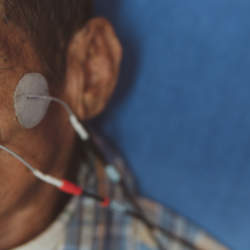Leber’s neuropathy is a rare genetic disorder that mainly affects the optic nerve, resulting in loss of vision. As a condition marked by unique complexities and challenges, understanding its underlying causes, available treatment options and long-term management strategies are crucial for healthcare providers and affected individuals. In this comprehensive guide, we’ll explore everything you need to know about Leber’s neuropathy.
Definition and Clinical Features
Leber’s neuropathy, also known as Leber’s Hereditary Optic Neuropathy (LO ON), is an eye condition that affects the ability to see detail and colour. It is a genetic eye disorder whose understanding is essential for medical practitioners, patients and their families. The following discussion looks in detail at its key features and clinical manifestations.
Symptoms
The clinical picture of NOHL usually begins with a sudden, painless loss of central vision.
- Onset: The disease often begins abruptly, with symptoms progressing over a period of days or weeks.
- Central Vision: Peripheral vision often remains intact, but the ability to see fine detail is lost.
- Initial Unilateral Affectation: Usually one eye is affected first, followed by the other over a period of time, which can range from a few weeks to several months.
- No Pain: Vision loss occurs without pain, which can sometimes delay diagnosis.
Genetic factors
The hereditary nature of NOHL is well established, and genetic mutations lie at the heart of the condition.
- Mitochondrial DNA mutation: The disease is associated with mutations in mitochondrial DNA, which is inherited exclusively from the mother.
- Maternal inheritance: Since mitochondria are inherited only from the mother, the disease can be passed from mother to son, but will not be passed on by fathers.
- Genetic analysis: Genetic tests can identify specific mutations and help with diagnosis and genetic counselling.
Prevalence and Demographics
Leber neuropathy has a particular demographic distribution.
- Prevalence: The prevalence of NOHL varies throughout the world, but it is considered a rare disease.
- Demographics: Although women can carry the mutation, the disease mainly affects men, usually in their twenties.
- Familial Incidence: The presence of several cases in a family can be an important clue to the diagnosis.
Diagnosis and Assessment
Diagnosing Leber neuropathy can be challenging. This section provides an overview of the various diagnostic methods and considerations:
- Clinical Assessment: Review of ocular symptoms and family history.
- Imaging Techniques: Optical Coherence Tomography (OCT) and Visual Evoked Potential (VEP).
- Genetic testing: Identification of specific mutations linked to the disease.
Treatment and management
Leber neuropathy has no definitive treatment, but there are several management strategies:
- Pharmacological options: Use ofidebenone, an antioxidant that can improve vision.
- Lifestyle Changes: Cessation of smoking and avoidance of certain medications.
- Regular follow-up: Monitoring progress and evaluating therapeutic interventions.
Living with Leber’s neuropathy
Living with Leber’s neuropathy, a condition that can seriously affect vision, requires a thorough understanding and significant adaptation. This visual impairment can have a significant impact on quality of life, but with the right support and rehabilitation services, these challenges can be managed.
Low vision aids:
The loss of central vision associated with Leber’s neuropathy can make everyday tasks difficult. Fortunately, there are a variety of low vision aids designed to assist affected individuals.
- Optical devices: Devices such as magnifiers and filters can be customised to help with activities of daily living such as reading and recognising faces.
- Assistance: The use of technological tools, such as screen readers and magnification software, can facilitate access to information.
- Education and training: Individuals can be trained to use these tools by low vision specialists, improving their independence and confidence.
Therapy and Coaching:
Vision loss can be an emotional and mentally challenging experience. Psychological support is therefore essential.
- Individual therapy: Follow-up with a specialist therapist can help manage feelings of loss, frustration and depression.
- Support Groups: Support groups offer a community of peers who understand and share the same experiences.
- Stress Management Techniques: Learning methods to manage stress, such as mindfulness and relaxation, can improve quality of life.
Community resources:
Communities and organisations can play a vital role in supporting people with Leber’s neuropathy.
- Support Organisations: Many organisations offer resources, training and networking opportunities for people with visual impairments.
- Rehabilitation Programmes: Specialist programmes can help develop new skills and adapt old ones to maximise independence and social participation.
- Community Involvement: Encouraging involvement in community and social activities can improve well-being and reduce isolation.
Naturopathic Care Plan
Naturopathic management of Leber’s neuropathy (NOHL) requires a well thought-out and structured approach. The treatment plan must be carefully developed in consultation with a qualified naturopath and in coordination with other health professionals involved in the patient’s care. Here is an example of a naturopathic management plan for NOHL, broken down into several steps.
Step 1: Complete Patient Assessment
The initial assessment should include a full history, including medical history, medical habits dietary habitslifestyle and stress factors. A thorough understanding of each patient’s condition is essential to develop a personalised treatment plan.
Step 2: Patient Education and Awareness
Educating the patient about NOHL and how naturopathy can play a role in managing their condition is crucial. The patient needs to understand the goals of naturopathic treatment and how it can complement conventional medical care.
Step 3: Therapeutic Nutrition
Therapeutic nutrition plays an essential role in the management of a variety of medical conditions, including Leber’s neuropathy. While conventional medical care remains central to the treatment of this condition, the naturopathic approach offers supplements that can support overall wellbeing and eye health. Step 3 of the detailed naturopathic management plan focuses on two key aspects: antioxidant diet guidance and guided supplementation.
Orientation towards an antioxidant diet
The antioxidant diet is based on the idea that antioxidants can help protect eye cells from oxidative damage.
Foods rich in antioxidants
- Green leafy vegetables: Vegetables such as spinach and kale are rich in lutein and zeaxanthin, two antioxidants important for eye health.
- Berries and Fruit: Strawberries, blueberries and citrus fruits are sources of antioxidants such as vitamin C.
- Nuts and seeds: These foods provide vitamin E, another essential antioxidant.
- Oily fish: Fish such as salmon contain omega-3 fatty acids, which have anti-inflammatory properties.
Eye Health Benefits
Antioxidant intake can help to:
- Reduce oxidative stress which can damage eye cells.
- Support retinal function.
- Complement conventional medical treatments.
Guided supplementation
In addition to diet, guided supplementation can be a crucial part of the naturopathic management plan.
Vitamin B and Zinc
- Vitamin B: Contributes to overall nerve health, including the optic nerves.
- Zinc: Essential for eye health and may support retinal function.
Step 4: Herbal Medicine in the Management of Leber Neuropathy
The incorporation of phytotherapy in the treatment of Leber’s neuropathy illustrates the ability of traditional medicine to co-exist with modern approaches. This stage of treatment focuses on the use of medicinal plants to support ocular function and reduce inflammation. It requires a deep understanding of medical botany and should always be guided by an expert in phytotherapy.
Selecting specific plants for Leber’s Neuropathy
Selecting specific plants is a delicate process which must be carefully tailored to the individual needs of the patient. Here are some key aspects of this process:
Assessing the patient’s needs
Before choosing the appropriate medicinal plants, a full assessment of the patient is necessary. This includes an examination of symptoms, medical history, current medication and any allergies.
Choice of medicinal herbs
The choice of herbs is based on their therapeutic potential in relation to the specific symptoms of Leber neuropathy. Certain plants may be particularly beneficial:
- Gingko Biloba: Known to improve blood circulation, including in the eye vessels, which can support optic nerve health.
- Turmeric: This spice has powerful anti-inflammatory properties that can help reduce inflammation in the eyes.
- Bilberry: Rich in antioxidants, bilberry can protect eye cells from oxidative damage.
Step 5: Stress management
Implementing stress management techniques can help manage the emotional impact of NOHL.
-
- Meditation or Yoga: These methods can help patients manage the stress and anxiety associated with their condition.
FAQ
What are the early signs of Leber neuropathy?
Early signs usually include a sudden, painless loss of central vision.
How is Leber neuropathy inherited?
It is inherited from the mother through mutations in the mitochondrial DNA.
Can Leber neuropathy be cured?
Currently, there is no cure, but there are treatments to manage the symptoms.
What are the risk factors for Leber neuropathy?
Genetic predisposition, male gender and environmental triggers such as smoking.
Is it possible to prevent Leber neuropathy?
Prevention is difficult because of the genetic nature of the disease.
What is the life expectancy for someone with Leber neuropathy?
Life expectancy is generally not affected, but quality of life can be impacted by vision loss.





